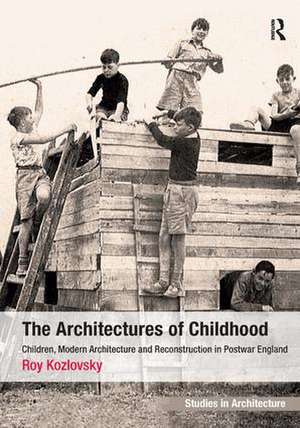The Architectures of Childhood: Children, Modern Architecture and Reconstruction in Postwar England: Ashgate Studies in Architecture
Autor Roy Kozlovskyen Limba Engleză Hardback – 13 mai 2013
Din seria Ashgate Studies in Architecture
- 8%
 Preț: 390.34 lei
Preț: 390.34 lei - 28%
 Preț: 821.14 lei
Preț: 821.14 lei - 24%
 Preț: 329.91 lei
Preț: 329.91 lei - 30%
 Preț: 768.30 lei
Preț: 768.30 lei - 11%
 Preț: 362.88 lei
Preț: 362.88 lei - 14%
 Preț: 325.34 lei
Preț: 325.34 lei - 24%
 Preț: 321.88 lei
Preț: 321.88 lei - 30%
 Preț: 776.81 lei
Preț: 776.81 lei -
 Preț: 449.41 lei
Preț: 449.41 lei - 30%
 Preț: 770.74 lei
Preț: 770.74 lei - 28%
 Preț: 823.99 lei
Preț: 823.99 lei - 22%
 Preț: 324.16 lei
Preț: 324.16 lei - 28%
 Preț: 881.28 lei
Preț: 881.28 lei - 14%
 Preț: 338.33 lei
Preț: 338.33 lei -
 Preț: 469.34 lei
Preț: 469.34 lei - 28%
 Preț: 878.01 lei
Preț: 878.01 lei - 12%
 Preț: 328.00 lei
Preț: 328.00 lei - 31%
 Preț: 767.47 lei
Preț: 767.47 lei - 18%
 Preț: 1012.89 lei
Preț: 1012.89 lei -
 Preț: 469.34 lei
Preț: 469.34 lei - 28%
 Preț: 826.84 lei
Preț: 826.84 lei - 26%
 Preț: 850.54 lei
Preț: 850.54 lei - 25%
 Preț: 710.66 lei
Preț: 710.66 lei - 13%
 Preț: 338.33 lei
Preț: 338.33 lei - 31%
 Preț: 767.67 lei
Preț: 767.67 lei - 16%
 Preț: 338.33 lei
Preț: 338.33 lei - 14%
 Preț: 340.33 lei
Preț: 340.33 lei - 26%
 Preț: 821.82 lei
Preț: 821.82 lei - 26%
 Preț: 821.53 lei
Preț: 821.53 lei - 28%
 Preț: 827.64 lei
Preț: 827.64 lei - 30%
 Preț: 768.69 lei
Preț: 768.69 lei - 28%
 Preț: 822.11 lei
Preț: 822.11 lei - 28%
 Preț: 799.76 lei
Preț: 799.76 lei - 28%
 Preț: 823.08 lei
Preț: 823.08 lei - 28%
 Preț: 826.01 lei
Preț: 826.01 lei - 30%
 Preț: 769.51 lei
Preț: 769.51 lei
Preț: 826.84 lei
Preț vechi: 1106.86 lei
-25% Nou
Puncte Express: 1240
Preț estimativ în valută:
158.23€ • 171.82$ • 132.92£
158.23€ • 171.82$ • 132.92£
Carte tipărită la comandă
Livrare economică 22 aprilie-06 mai
Preluare comenzi: 021 569.72.76
Specificații
ISBN-13: 9781409439776
ISBN-10: 1409439771
Pagini: 292
Dimensiuni: 174 x 246 mm
Greutate: 0.84 kg
Ediția:New.
Editura: Taylor & Francis
Colecția Routledge
Seria Ashgate Studies in Architecture
Locul publicării:Oxford, United Kingdom
ISBN-10: 1409439771
Pagini: 292
Dimensiuni: 174 x 246 mm
Greutate: 0.84 kg
Ediția:New.
Editura: Taylor & Francis
Colecția Routledge
Seria Ashgate Studies in Architecture
Locul publicării:Oxford, United Kingdom
Cuprins
Contents: Introduction; The Peckham experiment: functionalism and subjectivity; Adventure playgrounds: play on display; The architecture of educare; Children in hospital; Cradles of citizenship: housing and community planning; Team 10 and urban childhood; Afterword; List of references; Index.
Notă biografică
Dr Roy Kozlovsky, Department of Architecture, Northeastern University, Boston, USA.
Recenzii
'... it (the adventure playground) now has the scholarly account that it deserves: architectural historian Roy Kozlovsky’s very fine The Architectures of Childhood: Children, Modern Architecture and Reconstruction in Postwar England ... Kozlovsky provides a sympathetic but critical account of adventure playgrounds. He particularly questions the belief that play is a human instinct that surmounts its historical context.' The Architectural Review 'Each chapter is readable and informative in its own right, but what links them together, and what makes Kozlovsky’s study both more ambitious in its scope and more engaging than some of the design-led histories of the architecture the period, are strong theoretical underpinnings'. Journal of Historical Geography 'Roy Kozlovsky’s book ... elegantly and convincingly shows the central place of childhood in England in the years around World War II.' Journal of the History of Childhood and Youth
Descriere
Focusing on England between 1935 and 1959, this book examines a selected group of innovative buildings and environments that were designed for children or addressed their needs, such as playgrounds, schools, community centers, hospitals, dwellings and neighborhoods. It identifies the new aesthetic and spatial order permeating the environments of childhood, based on endowing children with the agency and autonomy to create a self-regulating social order out of their own free will, while rendering their interiority and sociability observable and governable.
